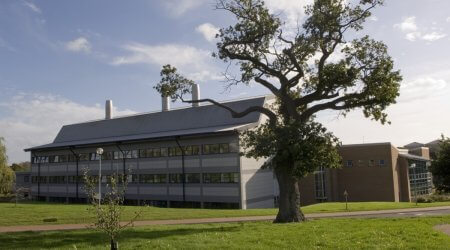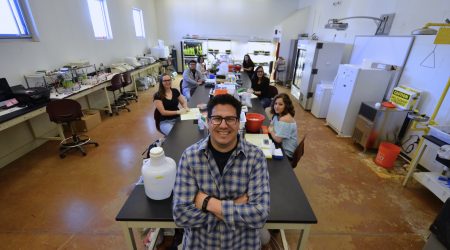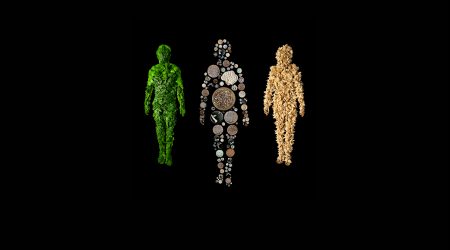Introducing our new Group Leaders
Dr Richard Smith
The Richard Smith group uses mathematical and computer simulation techniques to investigate questions in plant development.
Working in close collaboration with experimental biologists, they develop cellular-level simulation models of hormone signalling and patterning in plant tissue.
“It is often under-appreciated the synergy that exists between computer graphics and scientific simulation. I started my career in science in a computer graphics lab that was primarily interested in the simulation of realistic looking plants. In the pursuit of making things look real you often need to think less about describing how a pattern looks, and more about the processes that form it. Take the venation pattern in a leaf, for example. It would be pretty hard to specify all the detail of the pattern yourself, but if you can simulate the process of how a leaf venation network is formed mechanistically, then through simulating those processes you can create a realistic looking leaf.
“Knowledge, methods and even computer hardware (think GPUs) developed primarily for computer animation can be harnessed to make computer animations of developing plants, which really means understanding the underlying physics of plant development. This is how I ended up a Group Leader in a plant and microbial science research institute despite taking no biology classes until I started my PhD aged 41.”
Dr Antony Dodd
The Antony Dodd group investigates the adaptation of plants to fluctuating environments, focusing on circadian regulation and signal transduction.
“Circadian rhythms are what our bodies and many other living organisms use to measure the passage of time in order to co-ordinate their daily responses to the environment around them. My lab studies the circadian rhythms of plants, because they affect a number of important factors in plant performance; things like growth rates, seasonal flowering and the accumulation of various chemicals like starch are all controlled by the plant’s internal circadian clock.
“Understanding how these clocks work and the signalling pathways connecting a plant’s circadian rhythm and the rest of the organism, are therefore important on both a fundamental level but can also be applied to improving crops.”
Professor Matt Hutchings
The Matt Hutchings group works on the specialised metabolites made by Streptomyces species and closely related actinomycete bacteria, which include more than half of all known antibiotics.
They are particularly interested in the chemical ecology of these bacteria and their natural products. For example, antibiotic-producing actinomycete bacteria interact with insects and plants and protect them against infection by pathogenic bacteria and fungi in return for food and housing.
“I study Streptomyces bacteria because they are so important to humans – despite more than 50 years of ground-breaking Streptomyces research at the John Innes Centre, we are only just developing the tools we need to study these bacteria in the wild.
“My work is focused on understanding the roles of Streptomyces and their specialised metabolites, which are small molecules that most likely mediate interactions with other microbes, animals and plants in their natural soil environment. However, we still do not fully understand their functions in nature. Streptomyces bacteria make lots of specialised metabolites that are widely used in human medicine as antibiotics, immunosuppressants, antiparasitic and anti-cancer drugs.”
Dr Kelsey Byers
The Kelsey Byers group studies the evolution and diversification of floral scent at a wide range of scales, from genus-wide evolutionary patterns (lots of species) to floral scent evolution of pairs of species with different pollination systems (eg. hummingbird versus bumblebee).
They are also investigating how floral scent genes evolve in natural populations.
At present research focuses primarily on monkeyflowers in the genus Mimulus (also known as Diplacus and Erythranthe), a developing model system in evolutionary biology.
“Flowers use many traits to influence animal pollinator visitation, including colour, shape, and scent. By making sure that the ‘right’ pollinators visit in the right way, plants can ensure that their pollen is successfully transferred. We are a very visually oriented species so it’s easy to forget that many animals have better noses than we do and that floral scent is also vital. At its core, my research focuses on the evolution of floral scent in different flowering plant species.
“I’m particularly interested in understanding how floral scent has evolved across larger groups of species – genera – and how it has driven the evolution of different pollination systems, ie. the relationships between plants and their pollinators. Ultimately, I’d love to know whether floral scent plays a major or a minor role in this relationship compared with other floral traits, and whether that changes in different groups of flowering plants.”
Dr Philip Carella
The Philip Carella group aims to better understand how the diversity of land plants defend against pathogen infection.
To achieve this, they are establishing a curious, enthusiastic and innovative team that will explore the diversity of defence responses through comparative macroevolutionary analyses and molecular genetic approaches.
Using evolutionarily insightful models (Marchantia polymorpha, Selaginella moellendorffii, and Arabidopsis thaliana, among many others), the Carella group will investigate widely-conserved and lineage-specific aspects of plant defence that will inform future efforts to protect plants from harmful pathogens.
“When we think about plant diseases, we tend to focus on specialised interactions leading to susceptibility or resistance – but I think the fact that most plants resist most microbes is something really important from a macroevolutionary perspective – how do they accomplish this?
“The overarching theme of my research is to explore and understand the evolution of plant defence. I’m particularly interested in understanding how the critically-important plant defence pathways of our crops were first established when plants colonised land, and how these have evolved across distantly-related plants.”
Dr Sanu Arora
The Sanu Arora group explores the natural diversity of the Pisum species for environmental resilience.
“The demand for pea protein is expected to grow exponentially in the coming years, which is at odds with the highly volatile yield of pea. There are many factors causing this yield volatility, such as biotic and abiotic stresses and sub-par agronomic potential.
“I am interested in understanding the genetic basis underlying these causes with the objective of achieving yield stability. We will start by looking for genetic sources of resistance to devastating diseases of pea (root rots, powdery and downy mildews) against which the current control strategies are not particularly effective.”










